
Why AI Agent Tools Matter in 2025
In 2025, ai agent tools have moved from novelty to necessity because they handle the messy middle of work: unstructured inputs, shifting priorities, and decisions that change mid-task. Instead of brittle rules, modern agents reason through steps, consult multiple data sources, and choose the next best action in real time. Consider a Slackbot agent that can pull Salesforce data by opportunity ID, apply your sales policy, and answer follow-up questions without escalating to a human. Add an inbox summarizer that flags the five messages you must read before lunch, and an inventory alert agent that pings the right team channel before stock slips below threshold. Each unit is small, but the compound effect is large: fewer context switches, faster handoffs, and clearer priorities. Many teams complement these with a YouTube-to-blog agent, a newsletter creator, and a brand listening agent to close the loop from research to publication. If you’ve tried chatgpt voice, you’ve felt how natural speech can speed cognition; putting voice on top of these agents turns ideas into actions faster. That’s where voice-forward ai agent tools stand out: they let people ask, decide, and do in one flow.
From Workflows to Agentic Systems
Traditional automations execute a fixed sequence, while agentic systems plan, adapt, and coordinate across tools dynamically. This shift is visible across platforms: Zapier now supports natural language automation and LLM-driven logic; n8n offers flexible execution-based pricing for complex flows; Lindy AI targets business users with friendly orchestration; and Inkeep focuses on multi-agent coordination. The key difference is that ai agent tools evaluate outcomes at each step, then branch autonomously when reality diverges from the plan. For example, a social media sentiment agent might detect a spike in negative comments, trigger a brand listening agent to gather references, and then brief a personalized outreach agent to respond with context. Pricing also changes how you design: if a process spans 20–30 steps per ticket, execution-based billing can be more predictable than per-task fees. Think practically: if your lead scrape-and-categorize agent handles 1,000 records, and only 400 qualify for outreach, the agent can prune work early to save compute and time. You get resilience too—agents can re-try with alternative queries or tools when an API fails, rather than letting the whole chain break. The net result is fewer manual “save by hand” moments and more reliable, end-to-end outcomes.
Operational Use Cases That Pay Off
Real-world wins start with well-scoped agents. The Slackbot agent unifies policy Q&A, knowledge search, and CRM lookups so teams don’t ping specialists for routine answers. An email triage agent can categorize, label, and draft replies for 60% of incoming messages in a test scenario, leaving humans to finalize only the edge cases. A scrape-and-categorize-leads agent can enrich company data, score prospects by fit, and hand qualified leads to a personalized outreach agent that tailors messages by segment. On the ops side, an invoice processing agent extracts totals, due dates, and vendor IDs, then posts to the finance system, while an inventory alert agent prevents stock-outs by notifying the right channel before a threshold breach. Marketing can speed creation with a YouTube-to-blog agent and a newsletter creator that reuses the same vetted sources. When voice sits atop these ai agent tools, the loop tightens: speak “Summarize the last 24 hours of customer sentiment and draft a response plan,” and your AI can query social data, synthesize highlights, and propose next steps. Voice-led control makes multi-step orchestration feel immediate, which is why pairing agentic backends with voice interfaces often multiplies adoption.
Selecting and Integrating the Right Stack
Choosing ai agent tools starts with three questions: what decisions must the agent make, what data must it trust, and where should it act. For non-technical teams, no-code builders like Recomi and Voiceflow accelerate pilots; developers may prefer MetaGPT or cloud-native frameworks like Vertex AI for deeper control. Zapier Central and n8n help when you need broad integrations or custom node logic, while Gumloop-style data agents shine at large-scale processing. Map your sources—CRMs, ticketing systems, knowledge bases, data warehouses—and define read/write permissions to keep governance tight. Pilot with one measurable outcome, such as reducing support escalations or speeding lead response times. Then expand with multi-agent coordination: a Reddit researcher agent to surface unresolved complaints, a sentiment agent to quantify tone, and an outreach agent to close the loop. Layering a voice interface makes these systems accessible to everyone, not just builders; think of voice as the ergonomic front door to complex automation. Solutions like Sista AI add that voice-first layer with real-time, multilingual conversation, screen-aware guidance, and the ability to execute UI actions—so non-technical users can trigger sophisticated flows by speaking naturally.
Voice-First Agents as a Force Multiplier
Voice changes the posture of work from clicking to conversing, and that unlocks speed, accessibility, and adoption. Sista AI’s plug-and-play voice agents embed directly in sites and apps, bringing human-like conversation, rapid response, and on-screen awareness to your existing tools. Beyond chat, they act: a voice UI controller can scroll, click, type, and navigate; integrated RAG and knowledge bases provide grounded answers; full-stack code execution runs JavaScript or backend actions when the workflow demands it. With ultra-low latency and support for 60+ languages, cross-border teams get consistent, real-time experiences. Picture a support portal where customers say, “Show my last invoice, update my payment method, and open a ticket if it fails,” and the agent performs each step while explaining what’s happening. Or a storefront where shoppers narrow products by voice, compare options, and add to cart without hunting through menus. As ai agent tools keep maturing, voice becomes the natural control layer that hides complexity and amplifies results. If you’re ready to experience how a voice-first interface can lift your existing stack, try the live Sista AI Demo. When it fits your workflow, you can sign up and deploy in minutes with a simple snippet—no rewrites, no steep learning curve, just conversation that gets work done.
Stop Waiting. AI Is Already Here!
It’s never been easier to integrate AI into your product. Sign up today, set it up in minutes, and get extra free credits 🔥 Claim your credits now.
Don’t have a project yet? You can still try it directly in your browser and keep your free credits. Try the Chrome Extension.

For more information, visit sista.ai.

